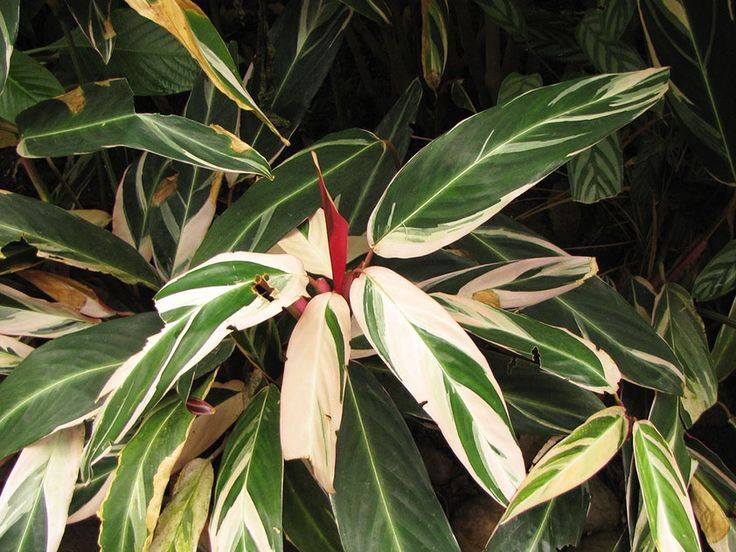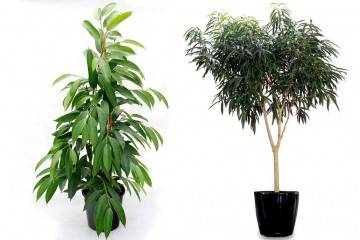Ktenant's flower - home care
Content:
Houseplants differ in appearance and leaf color. Some growers prefer to choose crops that are distinguished by their original colors. One of these plants is the ktenanta. The leaves of this flower have an interesting pattern, therefore, it is chosen quite often as a decorative culture, and many people are interested in the description.
What does the ktenant look like and what family it belongs to
The homeland of the ktenant (or ktenante) flower is South America and Brazil. You can meet culture in tropical forests. Under natural conditions, the plant can grow up to 2 m, at home the maximum size reaches 90 cm.
The culture has large oblong leaves, on which a variety of patterns. There may be streaks of pink or white, specks of beige or silver. On the reverse side, the leaves have a burgundy hue. By the evening, the twigs of the plant rise up, gather in a small dense bunch.
Flowering occurs during the summer season. Flowers are small spikelets covered with bracts.
Care at home requires special care for a ktenant, but an inexperienced florist can also cope if he strictly adheres to the rules.
Common varieties
Breeders have bred many interesting and varied species of ktenants. Each has characteristic differences:
- Ctenanthe Oppenheimiana. A wonderful and unpretentious variety, perfect for beginners. At home, it can grow up to 1.2 m. Oppenheim's leaves have the shape of lancets, differ in the alternation of gray and gray-green stripes;
- Ctenathe Lubbersiana is another fairly easy-to-care flower. The maximum plant height is 1 m. It is distinguished by the presence of oblong dark green leaves in the upper part. Below are leaves of a pale green hue with variegated veins;
- pubescent ctenant (Ctenanthe Setosa). This plant is considered the most capricious among all species. It requires certain indicators of humidity, temperature, drafts have a very negative effect on it. The leaves of the ctenant Setosis flower are ovoid, with a dark green tint diluted with light green stripes. The maximum flower height is 80 cm;
- Ctenanthe Amagris is a fairly well-known variety. Leaves are oval, they can be up to 20 cm long. The color is silvery-green with dark veins. In the lower part, the leaves have a burgundy color, which gives a special decorative effect to the plant;
- Ctenanthe Compressa. An interesting type of culture up to 0.9 m in size. Oval leaves up to 30 cm long. They have a rich green tint and a glossy surface;
- Ctenanthe Burle-Marxii. This flower is the lowest, up to 20 cm. Small leaf blades look quite original - thick and similar to a rectangle. On the upper part, wide dark stripes are noticeable, on the bottom - a dark red surface.
Features of caring for a plant at home
Ktenanta is an unpretentious plant. However, some types require adherence to certain rules. Therefore, it is recommended to know all the principles of caring for a ktenant at home.
Temperature
Culture is very fond of warmth. Throughout the growing season, it is necessary to observe the temperature regime and keep it at the level of 20-25 ° C. Sharp changes should not be allowed.
Lighting
The plant is undemanding to lighting. It does well in bright and shaded areas. It is better to place the flower pot on the west or north side. You can leave the flower in bright light, but cover it from direct sunlight.
It is worth remembering that the plant does not tolerate drafts.
Watering
Irrigation should be regular and moderate. The water is defended for several days, watered only warm. It is important to ensure that moisture does not accumulate in the pallet, but it is also impossible to allow the earth to dry out.
Spraying
The plant is native to the tropics, so it loves spraying. You need to carry out the procedure periodically. After a warm shower, the leaves are gently wiped with a cloth so that no drops remain.
Humidity
The ktenant also loves moist air. If the room is very dry, then the leaves begin to roll up, the death of the flower is not excluded. Therefore, it is recommended to create the necessary conditions for the crop, for example, using a humidifier.
Priming
The culture prefers loose and slightly acidic soil. You can cook it yourself by combining peat, humus and coniferous soil, adding a little sand and charcoal to the mixture.
If you wish, you can buy a ready-made mixture for arrowroot in the store.
Top dressing
Fertilize the flower from April to August twice a month. It is required to ensure that there is no excess of dressings, this is as harmful as their absence. For fertilization, special liquid dressings are used.
Features of winter care during the rest period
The plant does not need a particular dormant period. To make it grow better, you can slightly reduce the amount of watering and dressing in winter. The lighting should remain at the same level.
Pruning
If you do not control the growth and development of a flower, then gradually it becomes not as beautiful as before. Therefore, long and sluggish shoots and leaves are regularly removed. This will improve the process of flower development.
When and how it blooms
Ktenanta does not differ in luxurious flowering. The plant produces a spikelet with small flowers. You should not remove it immediately, it is better to do this after the first one has faded.
How the ktenanta reproduces
There are several ways to propagate a plant. The choice depends on the wishes of the grower.
Dividing the bush
Using this method, you can immediately get an adult plant, which is easy to care for:
- When transplanting with a sharp knife, the rhizome is cut into several parts, leaving a developed root and several leaves on each.
- Slices are sprinkled with activated charcoal and left to dry for several hours.
- After some time, the shoots are planted in separate containers and covered with plastic wrap.
- Watered with a weak solution of epin or root.
In order for the sprouts to take root faster, they are provided with suitable lighting and heating from below.
Apical cuttings
The method is used in the summer:
- From an adult plant, small cuttings are cut so that each has at least 3 leaves.
- Place them in water, covered with plastic wrap.
- After some time, roots form on the cuttings, after which they can be planted in the ground.
A newly planted plant must be properly looked after so that it takes root faster and begins to develop.
Transfer
Young specimens are transplanted every year at the end of spring. With an adult flower, this is done once every five years. The transplant is carried out by the transshipment method, adding new soil to the pot.
Too large a pot should not be taken, the container should be slightly larger than the root system so that the roots do not rot. And it is better to give preference to ceramics.
Diseases and pests
The main pests of ktenants are mealybug, whitefly, scale insect, spider mite. You can cope with them with the help of special preparations that are easy to purchase in the store.
All flower diseases arise as a result of violation of the rules of care. Decay of stems and leaves is possible. Otherwise, the leaf plates may curl or dry out.
Ktenanta is a beautiful ornamental plant that requires some attention and adherence to the principles of care. Otherwise, the flower will simply die.




















